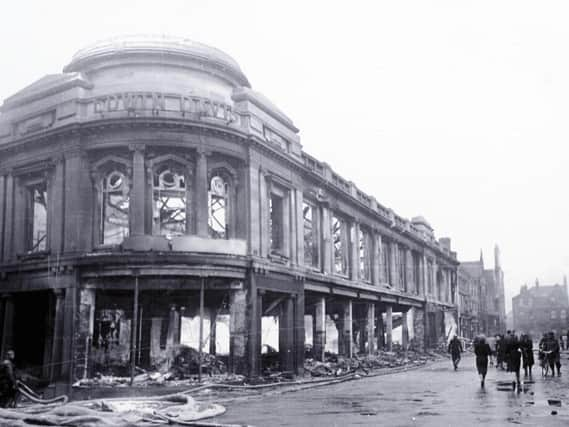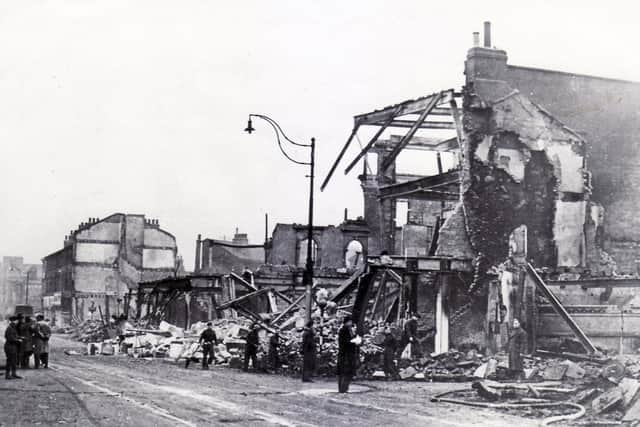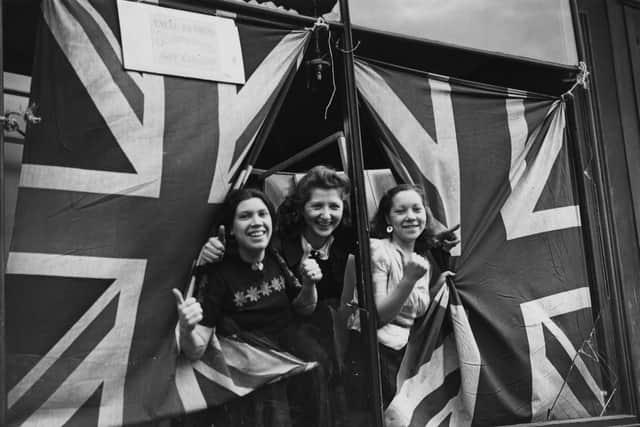The Blitz and the impact it had on some of Yorkshire's big cities


It was taken in December 1940 following a German bombing raid and while the streets around it burned, Sir Christopher Wren’s majestic cathedral remained intact. The image came to be seen as a symbol of the nation’s stoic defiance against the Luftwaffe’s onslaught.
St Paul’s survived, but many buildings that had also stood for centuries didn’t. Some estimates suggest that as many as 450,000 bombs were dropped on British towns and cities during the Second World War leaving behind an indelible mark on those that lived through these attacks.
Read more:


Advertisement
Hide AdAdvertisement
Hide AdThe first bombs were dropped one month and 13 days after Britain declared war on Germany. The Blitz – the most concentrated period of almost nightly bombing – lasted for eight months from September 1940, with the final air raids as late as March 1945.
London often bore the brunt of these relentless bombing raids. Yorkshire suffered badly, too. From Scarborough in the east, over to Halifax and the Calder Valley – nowhere was immune from the Luftwaffe’s deadly cargo. Worst hit, though, were the big industrial cities.
Sheffield’s Vickers factory was home to a 15 ton drop hammer – the only one in the country capable of turning out Rolls-Royce Merlin crankshafts for the Spitfire and Hurricane aircraft.
It also made components for tanks, as well as deck armour for warships and bomb castings. This made the city a likely target for the Luftwaffe, so people knew an attack was coming, they just didn’t know when.


Advertisement
Hide AdAdvertisement
Hide AdThe city had an early taste of what was to follow when a couple of bombs fell on the city in August, 1940, but it was nothing compared to what was unleashed on a chilly night a couple of weeks before Christmas that year.
When the shrill, dread sound of the air raid sirens sounded just after 7pm on December 12, families across Sheffield hurried to the nearest shelters.
Many of the cinemas and pubs were full and people were still dancing at the City Hall, until the police and air raid teams told everyone to find cover.
The first raid involved about 280 enemy aircraft and heralded a wave of explosives and incendiaries that fell on the city.
Advertisement
Hide AdAdvertisement
Hide AdAccording to reports, the main bombing period was one hour either side of midnight, with numerous areas being badly hit.
Sheffield had been bombed by Zeppelins during the First World War, which, though terrifying, were nowhere near as destructive. Every building in Angel Street was destroyed while The Moor, a popular shopping district, was described as a tunnel of fire during this particular raid.
Sheffield United’s Bramall Lane ground was also hit as was the Central Hebrew Synagogue, along with several churches.
One of the most harrowing incidents occurred when the seven-storey Marples Hotel on High Street suffered a direct hit before midnight. A bomb detonated just above the cellars, where people were taking refuge, killing about 70 and reducing the building to a 15ft-high pile of rubble. Shortly before the explosion, customers and staff had been singing.
Advertisement
Hide AdAdvertisement
Hide AdThe next day, seven men were dug out still alive, as a small section of cellar roof had somehow withstood the impact.
Three nights later, on the evening of December 15, around 100 German bombers, including Heinkels and Dorniers, returned, this time hitting the industrial heartland.
These attacks – which became known as the Sheffield Blitz – killed 668 civilians and 25 servicemen, injured more than 1,500 others and left a tenth of the city’s population homeless.
Despite the city’s pounding, there was no significant interruption to the war effort. In the aftermath, King George VI and Queen Elizabeth visited Sheffield and walked amongst the survivors to show solidarity with the city, while a short time later Winston Churchill arrived, delivering one of his trademark rousing speeches.
Advertisement
Hide AdAdvertisement
Hide AdAt the City Road cemetery, where 134 of the Luftwaffe’s victims were buried in a mass grave, a memorial garden was created, and today the Blitz is still remembered by those who survived.
On March 14 the following year, Leeds suffered its heaviest bombing raid of the war when bombs from around 40 enemy aircraft rained down on the city.
Leeds Museum, Kirkgate Market, Quarry Hill flats and the Metropole Hotel were among the buildings damaged. It proved to be the worst of the nine bombing raids on Leeds during the war that claimed 77 lives in total.
However, nowhere in Yorkshire suffered more than Hull. The full extent of the city’s wartime story took years to emerge and some of the physical scars can still be seen today.
Advertisement
Hide AdAdvertisement
Hide AdThough it suffered sporadic bombing from the summer of 1940 onwards, the Luftwaffe attacks intensified in March and April the following year when the city was pummelled in a series of particularly heavy raids.
This was a prelude to what became known locally as the Hull Blitz when two nights of terror starting on May 7, left 420 people dead and a further 350 seriously injured.
The intended target on this occasion had been Sheffield. But as well as being bombed because other targets could not be found, or were too well protected, Hull’s docks, industry
and railways were key targets themselves.
Reports at the time didn’t mention Hull by name in order to divert attention and play down its significance, and instead it was referred to obliquely as a “North-East town”.
Advertisement
Hide AdAdvertisement
Hide AdHull had been the subject of a “D Notice” – a voluntary request to the Press not to disclose certain information for reasons of national security, as the Cabinet was concerned the city’s suffering would lower national morale.
But while the rest of the country could only guess at the identity of the Luftwaffe’s latest victims, the people of Hull knew to their cost.
While the suffering of cities like Coventry and Bristol was widely acknowledged, it’s only in recent years that the plight of Hull during the Second World War has been recognised – it’s now believed to have been the country’s second most heavily bombed city after London.
By the time the war was over at least 1,200 people had been killed in the 82 bombing raids on Hull. In addition, more than half the city’s population were made homeless.
Advertisement
Hide AdAdvertisement
Hide AdIt took decades to rebuild our war-ravaged cities, but rebuilt they were, and while the Blitz left many buildings in tatters, the spirit of the British people, like St Paul’s, remained unbowed.
Editor’s note: first and foremost - and rarely have I written down these words with more sincerity - I hope this finds you well.
Almost certainly you are here because you value the quality and the integrity of the journalism produced by The Yorkshire Post’s journalists - almost all of which live alongside you in Yorkshire, spending the wages they earn with Yorkshire businesses - who last year took this title to the industry watchdog’s Most Trusted Newspaper in Britain accolade.
And that is why I must make an urgent request of you: as advertising revenue declines, your support becomes evermore crucial to the maintenance of the journalistic standards expected of The Yorkshire Post. If you can, safely, please buy a paper or take up a subscription. We want to continue to make you proud of Yorkshire’s National Newspaper but we are going to need your help.
Advertisement
Hide AdAdvertisement
Hide AdPostal subscription copies can be ordered by calling 0330 4030066 or by emailing [email protected]. Vouchers, to be exchanged at retail sales outlets - our newsagents need you, too - can be subscribed to by contacting subscriptions on 0330 1235950 or by visiting www.localsubsplus.co.uk where you should select The Yorkshire Post from the list of titles available.
If you want to help right now, download our tablet app from the App / Play Stores. Every contribution you make helps to provide this county with the best regional journalism in the country.
Sincerely. Thank you.
James Mitchinson
Editor